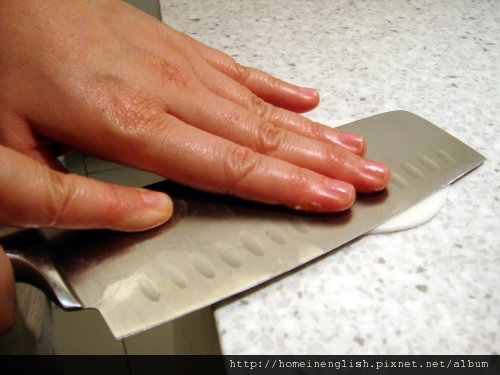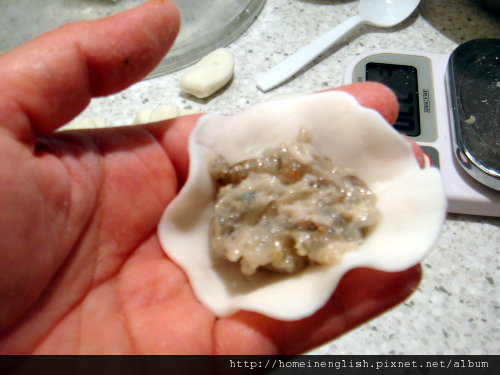The reputation of a dim sum restaurant seems to rest on the quality of the shrimp dumpling. In fact, the shrimp dumpling represents the culmination of taste, visual, and olfactory sensations in culinary art.
The most important ingredients in making a delicious shrimp dumpling are good quality shrimp and wheat starch.
How to choose shrimp: raw shrimps should have a gray/black with a tint of blue color. Do not buy ones that have been soaked in borax. Borax is not only unsafe for human consumption but also changes the taste and texture of the shrimp. Do not rinse the shrimps at home. Blot the excess moisture away with paper towels, marinate, then store in the refrigerator. Shrimps processed this way will naturally develop that crisp snapping texture.
What is wheat starch? The main components of flour are gluten and starch. Combine water and flour together and knead into a dough. The dough is kneaded until gluten is fully developed then kneading continues in a bowl of water. During this process, starch will precipitate out and the dough is left with insoluble gluten. Remove the gluten ball and dump the water out of the bowl. Wheat starch is the dried precipitated starch at the bottom of the bowl. The gluten ball can be cut into small pieces and fried or used in vegetarian dishes like kao fu (torn gluten pieces).
Wheat starch is used in many dim sum dishes. The shrimp dumpling wrapper is made of wheat starch with a little bit of Tai Bi powder (potato or tapioca starch). It is not easy to find wheat starch in Taiwan, so I usually use corn starch with Tai Bi powder to make the shrimp dumpling wrapper. No one can taste the difference.
Corn starch is derived from corn. There are two different types of Tai Bi powder on the market: starch from potato or tapioca. The package will tell you whether the starch is extracted from potato or tapioca. If the wrapper is made with corn and potato starch, the ratio of each is 5 : 6. If using corn with tapioca starch, the ratio is 8.5 : 2.5.
Starch has straight-chain and branched forms. Each kind of starch has a unique ratio of the two. Cooked straight-chain starch is not sticky, not very chewy, and holds its shape nicely. Cooked branched starch is very sticky and very soft. The best example of a branched starch is sticky rice flour. It contains almost inclusively of branched starch. So cooked sticky rice flour is extremely sticky, very chewy, and usually spreads out like a goo. Warming the rice cake made of sticky rice flour directly on the baking rack in the oven will create a sticky gooey mess on the bottom.
I use a combination of corn, potato, or tapioca starch to get the same straight-chain and branched starch ratio like wheat and potato starch combination. When the ratio is correct, the wrapper texture will also be correct.
Ingredients Yield: 40
Filling:
Shrimp – 500 g
Ground pork fat – 50 g (see note 1)
Salt – 1 teaspoon
Sugar – 1 tablespoon
White pepper – to taste
Sesame seed oil – to taste
Wrapper:
Corn starch – 100 g (see note 2)
Tai Bi powder (potato starch) – 120 g (see note 2)
Hot water – 220 g (see note 3)
Lard or vegetable oil – 1 tablespoon
Steps:
1) Make the filling: devein the shrimps. Blot the excess water away with paper towels. Cut the shrimps into small dices.
2) Combine the shrimp dices, fatty ground pork, and flavorings in a bowl. Whisk the ingredients together for 1 – 2 minutes until the mixture becomes sticky. Refrigerate.
3) Make the wrapper: put the corn and potato starch in a bowl.
4) Add hot water. Whisk the starch together into a dough. Mix evenly to prevent lumps.
5) Cover the bowl and let the dough cool.
6) While the dough is cooling, get the steamer ready. Fill the steamer with water to half full. If using a stainless steel steamer, wrap the lid with a big cloth. This will prevent water dripping from inside of the lid down to the steaming dumplings. Prepare two round plates lined with steaming or parchment paper.
7) Add lard to the cooled dough. Knead it on the bench until the surface is smooth with a slight sheen.
8) Roll the dough into a long rod with the thickness of the rolling pin.
9) Cut the dough rod into small pieces (~11 g). Cut a few pieces at a time and cover the unused portion to prevent it from drying out.
10)Use the blade of a knife to flatten the dough into a round disc (~8 cm). If the dough sticks to the blade, rub a tiny bit of oil on the blade to prevent sticking (see note 4).
11)Use the knife to scrape the flattened dough disc up from the bench.
12)Add about 14 g of shrimp filling on the dough disc.
13)Fold the dough to close the dumpling.

14)Put the shrimp dumplings on the round plates.
15)Let the water in the steamer boil first then steam the shrimp dumplings (on plates) for 5 minutes. Eat them while hot. Wrap any leftovers with plastic wrap and they can be stored in the fridge up to two days.
Note 1:
Many Chinese or dim sum dishes need to use a little bit of ground pork fat. I usually buy a couple of pounds at a time. I put the ground pork fat in a plastic bag and shape it into a log then freeze it in an air-tight container. Simply slice off enough ground pork from the frozen block when the recipe calls for it.
There are two kinds of pork fat: from the back or belly. Pork back fat is more sinewy and better at being cooked down to make lard or grounded up to be used in a filling. Like the ground pork fat in this recipe, some fat melts during the cooking process to moisten the filling and the unmelted ones creates the “snap” feel when one bites into the dumpling.
Pork belly fat is useful in making many sweet items. The fat is cut into strips or dices then marinated with sugar. The sugary fat is frozen for about a week and becomes icy fat. Icy fat melts immediately when it is steamed and creates that smooth and satisfying mouth feel in the sweet dessert.
In the US, the meat counter in the Asian supermarket should have pork back or belly fat. Ask the butcher to ground up the fat for you.
Note 2:
Readers can use 170 g corn starch + 50 g tapioca starch, 200 g wheat starch + 20 g tapioca starch, or create your own combination to get desired texture.
Note 3:
Hot water should be ~ 98°C on cold days; 90~95°C on warm days. The water temperature will affect the stiffness of the dough. Warmer the water, stiffer the dough. The dough must be pliable to make beautiful shrimp dumplings.
Note 4:
Using the knife blade to flatten the dough is a quick short cut. But if you have a problem with this technique, use a rolling pin to roll the dough into a round disc.















 留言列表
留言列表